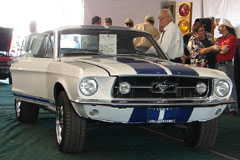You want to buy a collectible vehicle. Maybe, it's the Corvette or Mustang couldn't afford when you were younger. Or perhaps, it's a convertible or sports car. Nice vintage vehicles are quite expensive, you want to be sure you get what you are paying for. This is vital if you are buying a collectible not only for fun, but also as an investment.
 |
| "The Judge" option can make a Pontiac GTO even more valuable. |
Before shopping for a particular collectible, do your homework, meaning lots of reading. There is hardly a vehicle that has not had a book written about it. In the case of popular brands like Fords and Ferraris, there are hundreds. Do a Google search on any vehicle and you will turn up more then enough information, often written by owners with lots of experience. Car clubs are great sources of information. Once you belong, it won't be long before you discover members who are the walking encyclopedias of knowledge about the brand and individual models.
For collectibles like Corvettes and muscle cars top value requires that "all the numbers match." This means the key parts, especially the engine and drivetrain, are the ones originally installed, even though restored and rebuilt. Here the important information is on the identification plates found on these cars. Learn how to "translate" the codes into colors, engines, options, and so forth. For some cars it is even possible to obtain copies of the original invoices. Window stickers are another great way to verify originality.
Frauds often include modification of a high-production model into a rare, limited-edition model. Fakes are common with muscle cars. Here a mere change in engine, or even options, can substantially increase the value. For instance, the early Pontiac GTOs and Oldsmobile 442s were simply option packages on the Pontiac LeMans or Oldsmobile F-85s. Thus, it is relatively easy to make a much more valuable GTO or 442 out of an ordinary LeMans or F-85. Back in the 1960s, people replaced the split rear windows with the single piece 1964 rear window in their 1963 Corvette Sting Ray coupes to eliminate the notorious blind spot. With the premium price for "split windows" today, the windows have been replaced along with a few '64s that have received the same treatment.
 |
| Know what you are buying before you start bidding. |
There are other changes to increase values with a modest investment in time and money. The addition of a "Pony" interior to a '65 Mustang could result in an increase of an additional thousand dollars or more to the value. This goes likewise for things like a "power pack" on a '55-57 Chevrolet, or a McCulloch supercharger added to a normally aspirated 1957 Ford 312 cid V-8. In the most unfortunate cases, it is done by merely switching or altering the identification plates.
Knowing whom you buy from can decrease the chance of being taken. Probably the best bet is to buy from a hobbyist who specializes in a particular brand or even a particular model. He probably has the complete story on the car, documented with receipts and photos. If he restored the car himself, he undoubtedly has a scrapbook with photos covering the entire process. If there are any lapses in authenticity, they are usually because of human error or personal preference, rather than an attempt at fraud. If you buy the car, make sure to get the documentation and the scrapbook. It will increase the value of the vehicle and aid in selling it.
Be especially careful when considering cars with an "interesting" history. I wonder how Elvis ever had time to drive all those cars he "owned." Or how about vintage racers that are touted as having a "racing history." Were they the real car or just backup vehicles that never left the pits?
Even the, manufacturers have produced "fakes." For example, when Ford ran out of 428 V8s in 1968, 390 cid V8s were substituted in the Shelby-Mustang GT500. While externally the two engines' look identical, there is a 75 horsepower difference. Also some of the legendary AC Cobra 427s actually came with the 428 cid V-8s meant for Ford Galaxies and Thunderbirds.
One good way to protect yourself is to have the seller sign a notarized statement covering the originality of the car. While sellers may speak untruths when trying to sell a car, they will become a lot less boastful when they have to commit the same statements to a legal piece of paper. Also, if the owner has lied, you have some strong evidence to go to court with.
Buying at an auction can bring lots of problems. I went to one recently and I saw cars being misrepresented. There were also "cosmetic restorations" that looked great under the indoor lighting. I even smelled fresh paint as one red (naturally) convertible crossed the auction block. The bottom line is if you buy at an auction, know what you are buying, and avoid impulse buying unless you recognize a real bargain.




